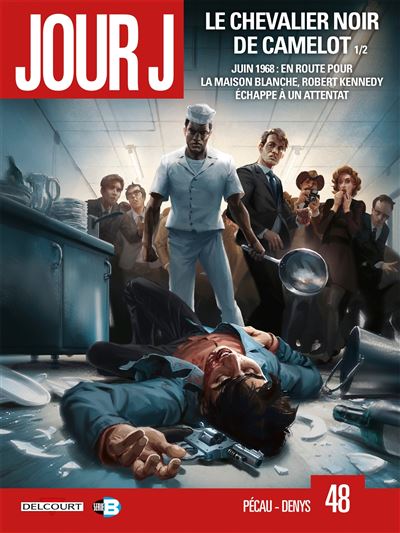Sixteenth volume of Jean-Yves Delitte's series devoted to the great naval battles of history, Gravelines, the invincible Armada takes us to the sixteenth century, at a major turning point in the balance of European forces, when the Invincible Spanish Armada of the very Catholic Philip II was swept away by the modest English navy of Elizabeth I, The Protestant Virgin Queen. Already rich in fifteen albums, the previous one of which was released only a week before this one in October 2020 (see Gondelour), Jean-Yves Delitte does a beautiful job of historical popularization, without falling into the sometimes off-putting didacticism of this kind of exercise. And unlike the previous volume, he entrusted the drawing to his colleagues Denis Béchu, Giuseppe Balguera and Nico Tamburo who had already officiated on some previous albums of the series.
Along the way, the historical series expands
The first pages therefore quite skilfully present the context and the facts that will lead Philip II to decide to invade England. Then, we are transported to Spanish Flanders where we follow two soldiers in their daily lives, which allows the reader to become attached to the universe that is portrayed to us. The events then follow one another most naturally in the world, perhaps in a way a little too classic say some – but the goal here is not to make the novel – and passing from the Spanish lines to the court of Elizabeth to return to the field and finally to the battle itself, we do not really have time to get bored during the reading.
Gravelines:D the coldness of contemporary coloring
We will only regret the ugliness of the coloring that literally spoils some boards. Everything is bistre or khaki. There is never light, not the slightest bright color (the blue sky is never sky blue, the grass is never green but always goose poop, the reds or yellows are never frank and there is no white). The fire is brown instead of burning yellow, orange and red. There is not the slightest sensation of light, not even in the sunny sky of Spain. If this big flat (recurring problem of modern comics) does not spoil the work of the authors, it nevertheless reduces the pleasure of reading.  We can add that at the end of the album, there are a few pages of a file summarizing the time in general, giving some clarifications on the context which are very interesting and which may make the reader want to go further to dig into the question (Note two errors a little embarrassing in the text, when the author speaks of "stratagem" instead of "strategist" and "curia" instead of "curée"). In the end, the album is an opportunity to remember one of the most famous moments in the history of naval battles of all time. And if we did not already know the facts, it is very likely that an interested reader will want to discover more, whether in terms of naval battles famous by the other volumes of the series (Glénat) or on this one in particular by reading history books.
We can add that at the end of the album, there are a few pages of a file summarizing the time in general, giving some clarifications on the context which are very interesting and which may make the reader want to go further to dig into the question (Note two errors a little embarrassing in the text, when the author speaks of "stratagem" instead of "strategist" and "curia" instead of "curée"). In the end, the album is an opportunity to remember one of the most famous moments in the history of naval battles of all time. And if we did not already know the facts, it is very likely that an interested reader will want to discover more, whether in terms of naval battles famous by the other volumes of the series (Glénat) or on this one in particular by reading history books.















![[Live Report] Rock En Seine 2024 : 20 ans et toujours aussi passionnés !](https://www.justfocus.fr/wp-content/uploads/2024/11/RES24_JOUR01_LANA-DEL-REY_LOUIS-COMAR-12.jpg)






















